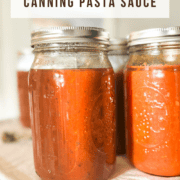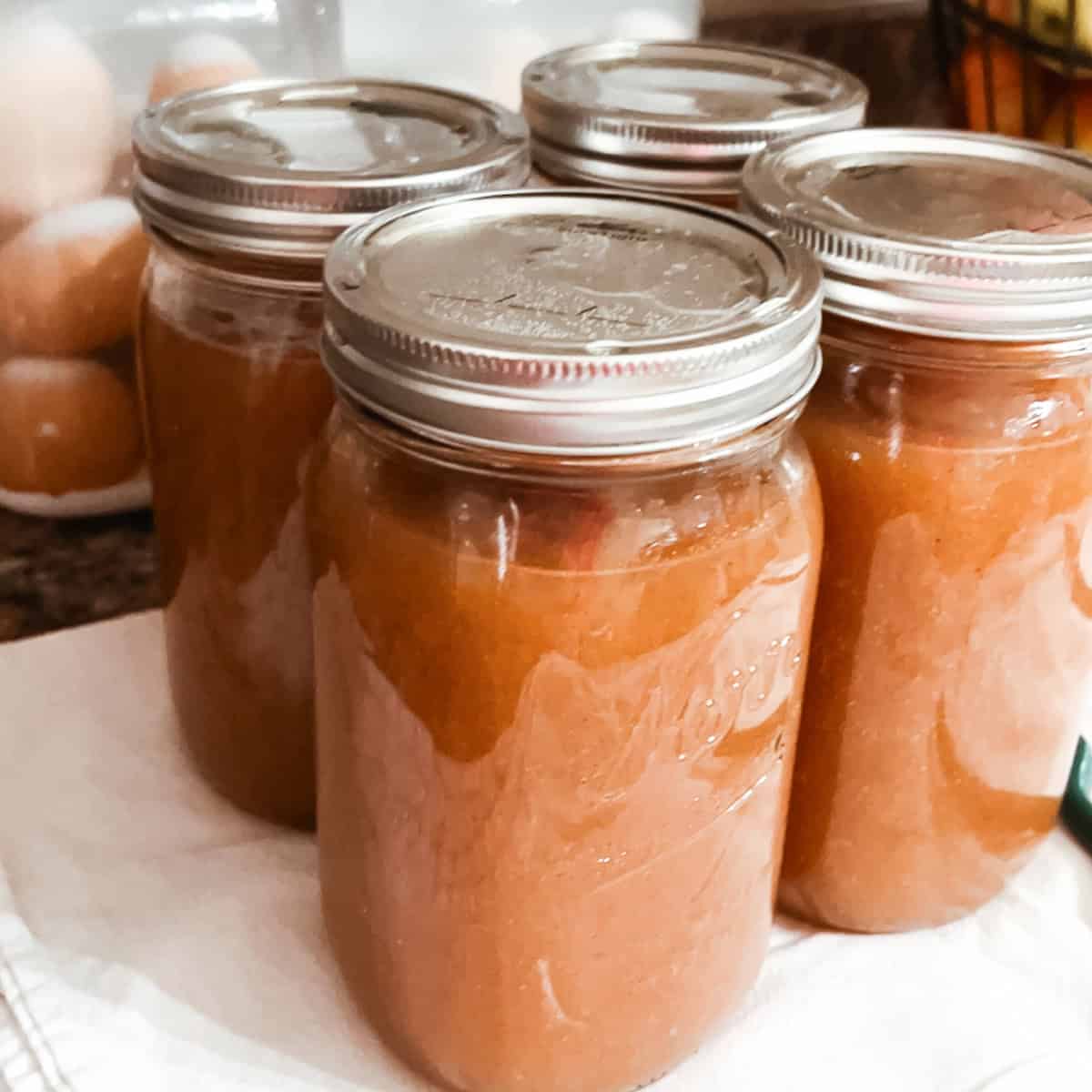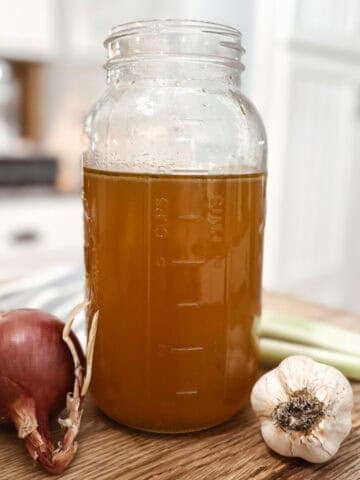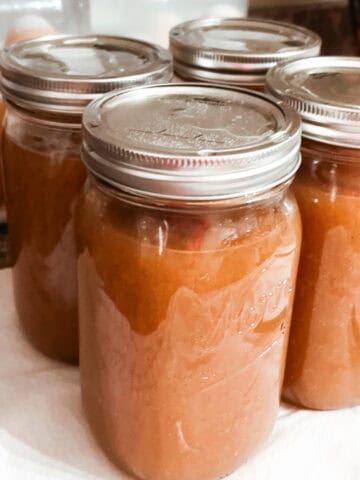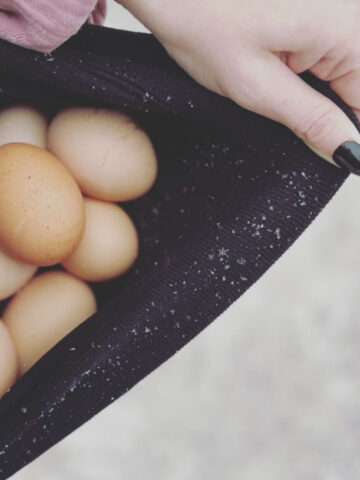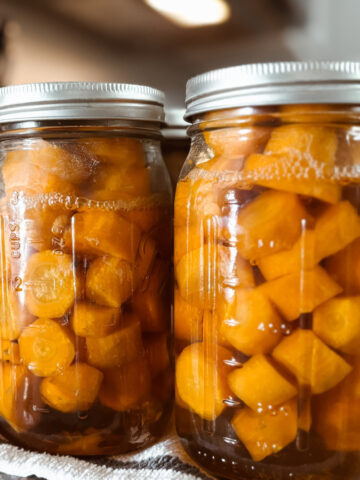Canning can be intimidating and scary for those who have never done it, but it doesn’t have to be! I personally know people who will only eat their garden produce fresh, or who will process and freeze their harvest rather than canning it. This is simply because they are afraid of using a pressure canner or scared something will go wrong and the whole family will end up with botulism or food poisoning. There is nothing wrong with eating the produce fresh or freezing it, of course, but canning isn’t as difficult or scary as it may seem! There is an easy way that simply uses boiling water - water bath canning. This step-by-step instruction makes canning homemade spaghetti sauce (for beginners) a breeze!
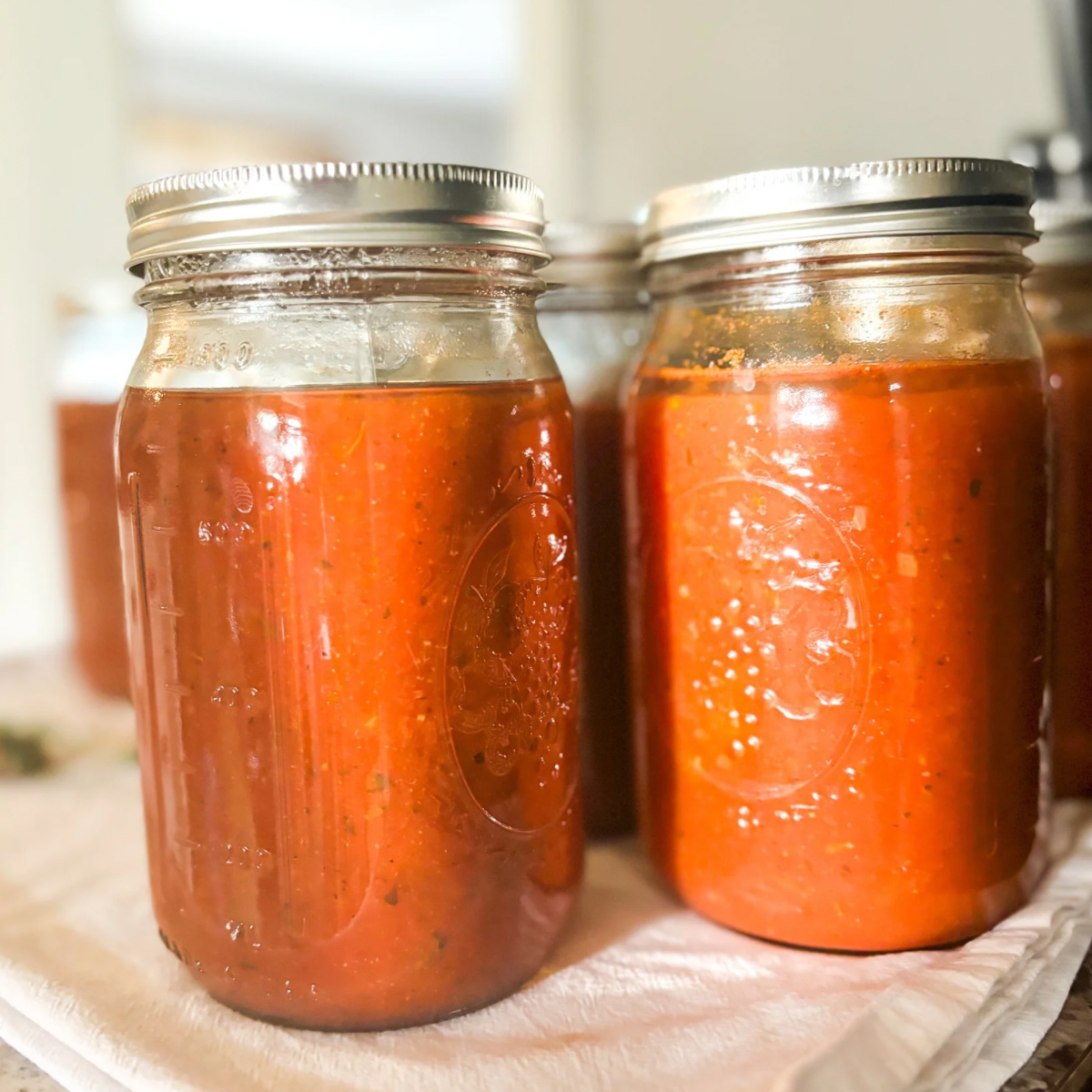
I was fortunate to have grown up in a family of gardeners - learning to plant, care for, harvest and can a garden from a young age. Now, my husband and I have multiple large gardens on our property and enjoy growing, harvesting, and canning our loot as a family. Here, I will teach you step-by-step how to easily process the fresh tomatoes, make the pasta sauce, and water bath can the homemade spaghetti sauce. This is a tried and true process that our family has followed for years, and great for a beginner canner! That being said, prepare to enjoy the bountiful tomato harvest, in the form of pasta sauce, throughout the year!
Jump to:
- What is special about this canning method and recipe?
- Why make pasta sauce when you can buy it?
- The Best Tomato Varieties for Homemade Pasta Sauce
- Ingredients Needed
- Equipment Needed
- Instructions
- Storage:
- Alternative Preservation Methods:
- Using the Homemade Spaghetti Sauce:
- Canning Homemade Spaghetti Sauce (for Beginners)
- Pin this post for later here!
- More Home Food Preservation Posts:
- Making and Canning Homemade Applesauce - Step by Step
- Methods for Preserving Farm Fresh Eggs for Winter
- Pressure Canning Carrots - Easy Method (How To)
What is special about this canning method and recipe?
This method and recipe is perfect for beginners. It is easy and simple, only requiring 3 ingredients - tomatoes, sugar, and Mrs.Wages Pasta Sauce Mix! Mrs. Wages Pasta Sauce Mix takes the guess work (and a lot of prep work) out of the sauce making process. All of the seasonings and spices needed to make a delicious spaghetti sauce are right in the packet, and it is free of artificial flavor and color. I like to keep things very simple and easy during the canning sauce making process, and when it comes times to use the pasta sauce I may add in onions and mushrooms, green peppers, other bell peppers, bay leaves, fresh herbs, etc. while I cook it up. Typically, any extras are added in with browned hamburger, (browned ground beef), then the sauce is added in and heated to add to noodles. Or we eat it as is, as it is delicious without being all dolled up too. So essentially, this spaghetti sauce recipe is more of a marinara sauce recipe (thinner and a little more basic) and can be jazzed up when it is being cooked to serve.
Why make pasta sauce when you can buy it?
There is something very rewarding about being able to grow, harvest, and preserve your own food. These skills have been passed on for years and I think that is pretty neat. In addition, I prefer to minimize processed foods where I am able. This helps my family eliminate excess added sugars and preservatives where we can. So in short, it is healthier, cheaper, and more delicious. We prefer home canning over the grocery store version.
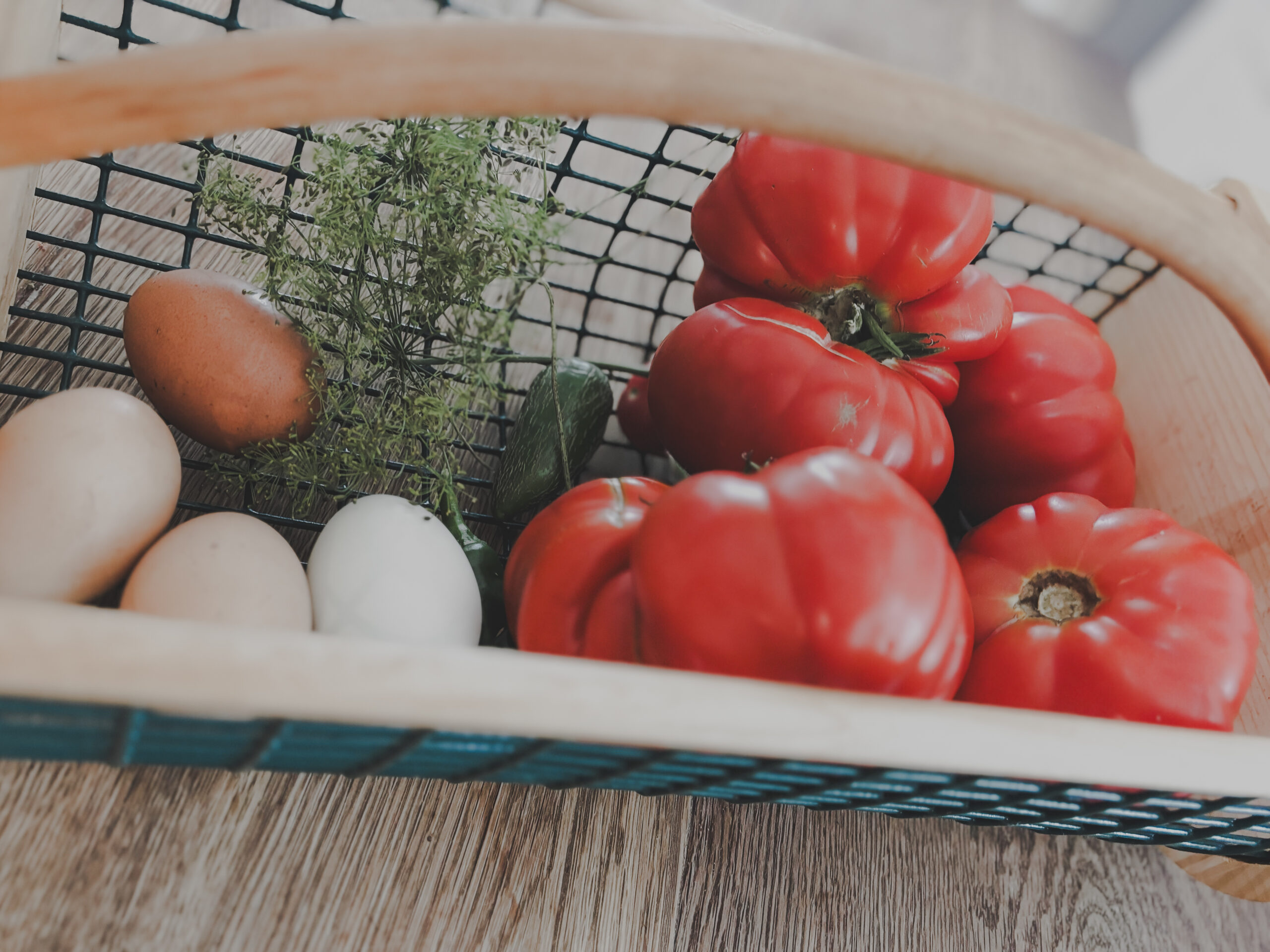
The Best Tomato Varieties for Homemade Pasta Sauce
If you are growing your own tomatoes, this is something to take into consideration when picking out your plants for the garden, or the seeds to purchase if starting the plants from seed. Different tomato varieties are better suited for different uses. The tomatoes that are beefier with a meaty texture, and contain very few seeds (if any), are the best choice for making homemade pasta sauce. That being said, paste tomatoes such as Roma or San Marzano are my go-to varieties. However, I will use up whichever tomatoes need to be dealt with when it comes to making and canning homemade spaghetti sauce, as long as they are ripe tomatoes (and bug free).
Ingredients Needed
- 6 pounds of fresh tomatoes (approximately 18 medium tomatoes)
- ¼ cup of sugar
- 1 packet of Mrs. Wages Pasta Sauce Mix
See recipe card for quantities.
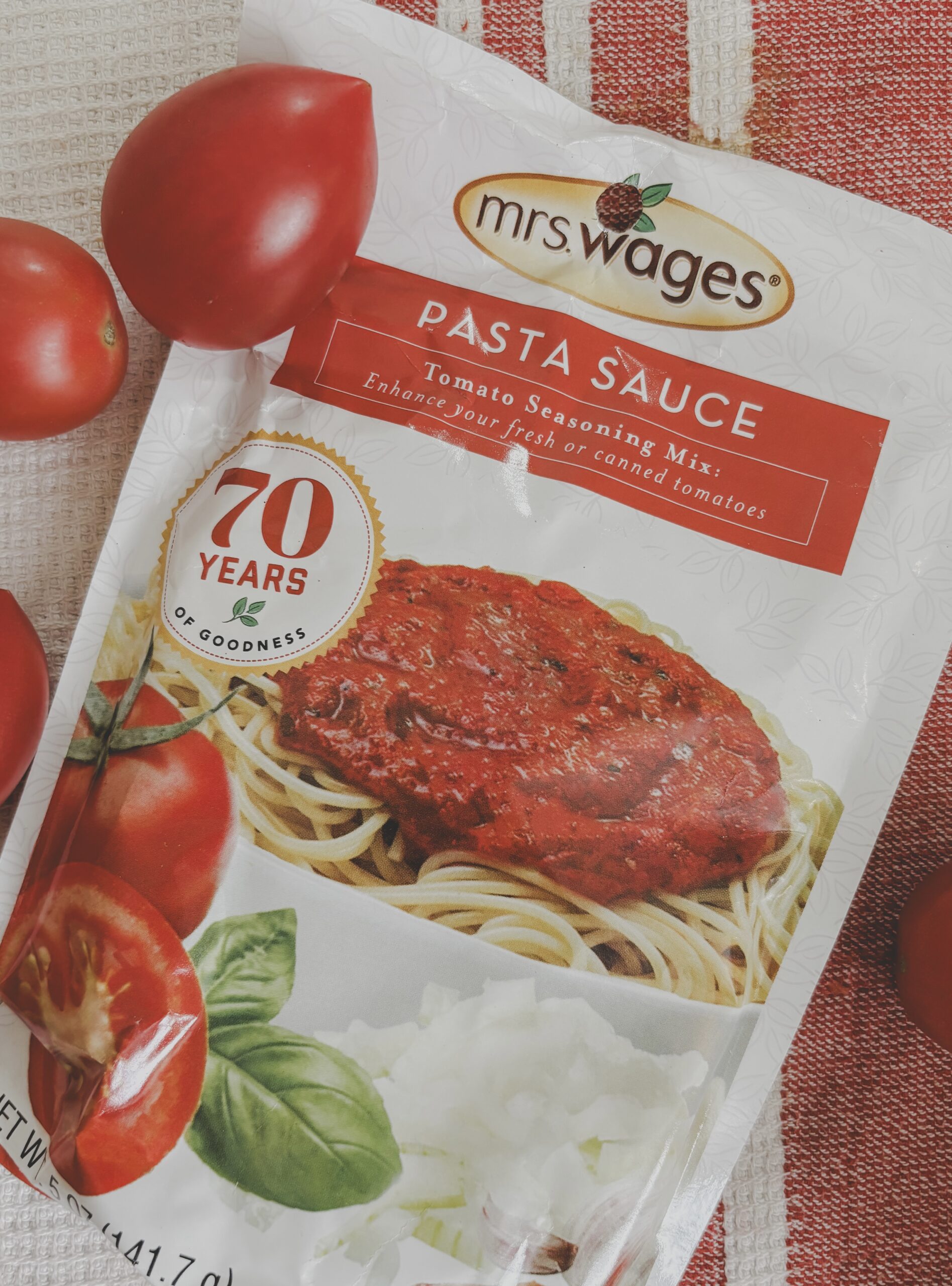
Equipment Needed
- Canning specific items - here is a great deal on a full water bath starter canning set with the following included:
- Large water bath canner
- GraniteWare Blancher (or use a large pot and a food strainer)
- Canning Tools - a great kit makes life easier! (jar lifter, funnel, magnetic lid lifter)
- Sauce Master Food Strainer - this really simplifies the process and saves A LOT of time! We use ours for tomatoes, apples, and other canning projects, and it has lasted us for years. (or use a blender, immersion blender, or food processor)
- Large Mixing Bowl
- Medium Mixing Bowl
- Small Mixing Bowl
- Canning Jars - Quart Jars (new mason jars and lids or used jars with new lids - seal must be intact) I recommend wide mouth jars, they are easier to work with, but regular work just as well.
- A large cooking pot to cook the spaghetti sauce - not enamel.
Instructions
Step 1: Sterilizing the Mason Jars and Lids
There are multiple ways to do this:
- Dishwasher Method - Some dishwashers have a sanitize function on the dishwasher which works well for preparing the mason jars. The downfall, however, is this can be a time consuming method.
- Oven Method - Wash the jars with soap, rinse, but do not dry. Place upside down on a baking sheet and put in the oven for 20 minutes at 275 degrees Fahrenheit (130 degrees Celsius). Carefully remove the hot jars for canning.
- Boiling Method - Wash the jars with soap and rinse. Place jars in a large pot of boiling water (like the water bath canner) and let them sanitize for 20 minutes. Remove jars and let air dry before use.
For the lids - place in a small sauce pan of hot water until it is time to add them to the jars.
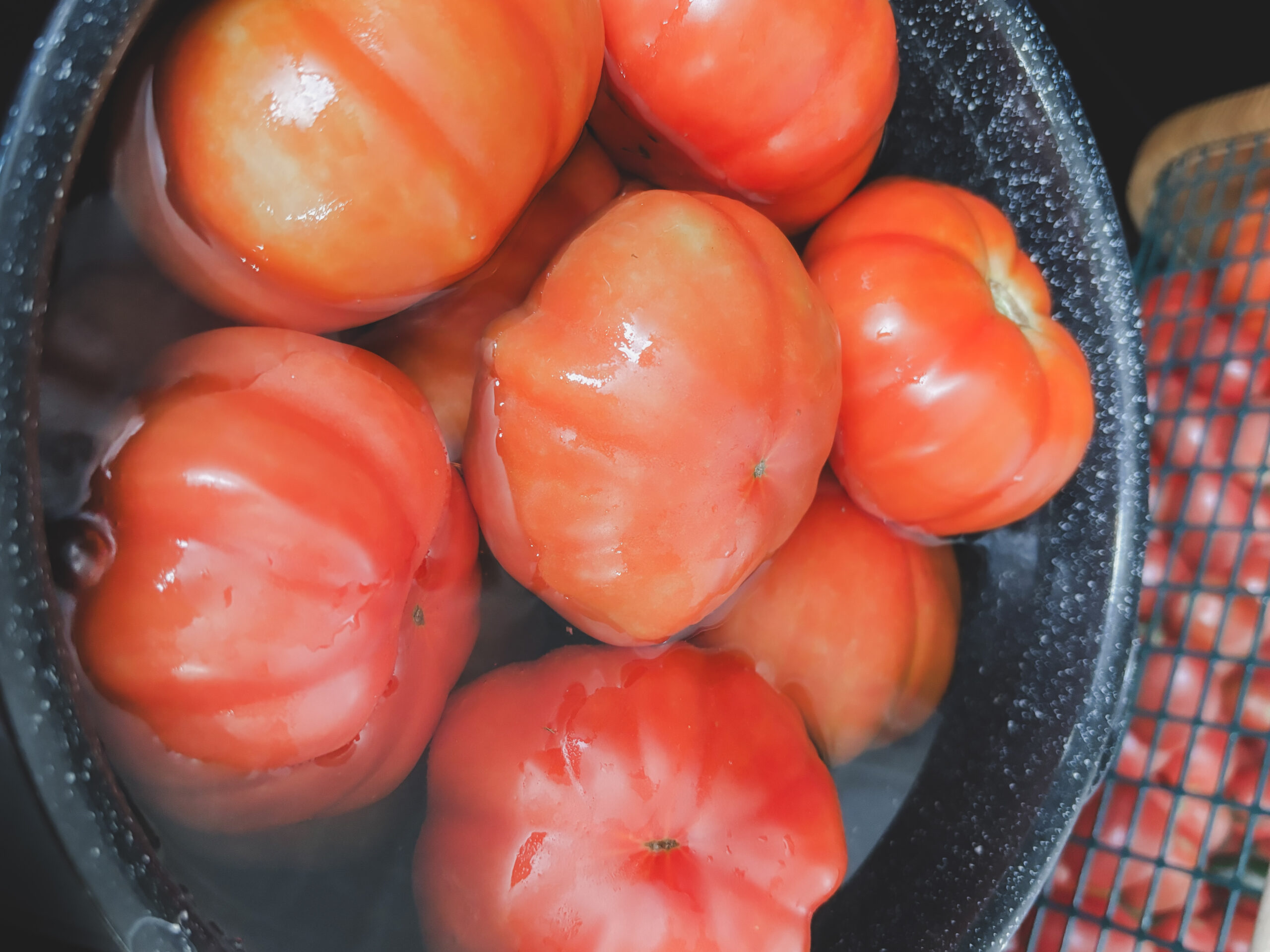
Step 2: Processing the Tomatoes
First wash the tomatoes. Then fill the outer blanching pot (or any large pot) ⅔ full with hot water and bring to a boil. Add the tomatoes and scald for 3 minutes. (The skins will start to crack, indicating they are ready). Place the drainer insert into the sink. Poor the tomatoes from the blanching pot into the drainer insert, and rinse with cold water or ice water. Place the drainer insert with the tomatoes back into the blanching pot to transfer to the Sauce Master Food Strainer.
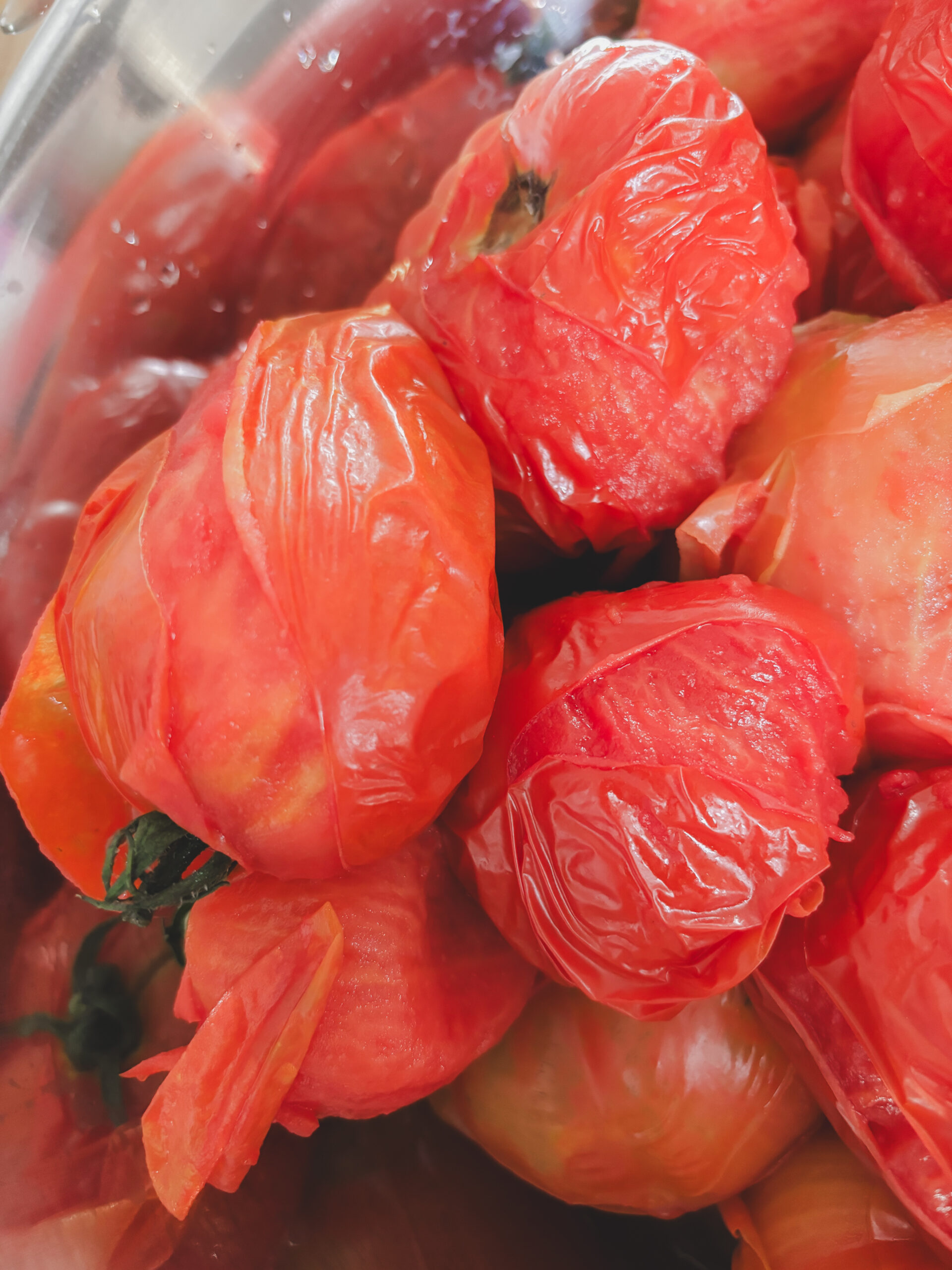
Carefully add the tomatoes to the sauce master and process through the mill. Place a medium bowl below the shoot to catch the tomato sauce or tomato puree, and a small bowl below the open grind end to catch the tomato skins and seeds. See “Important Notes” section below for alternative methods.

Step 3: Making the Spaghetti Sauce
Combine the puréed tomatoes, sugar, and Mrs.Wages Pasta Sauce mix into a large non-reactive pot or saucepan. (There should be about 10 cups of puréed tomatoes - if I am doing multiple batches I will measure out 10 cups for each batch.)
Bring to a boil, stirring occasionally. Reduce heat and simmer for 25 minutes, still stirring occasionally.
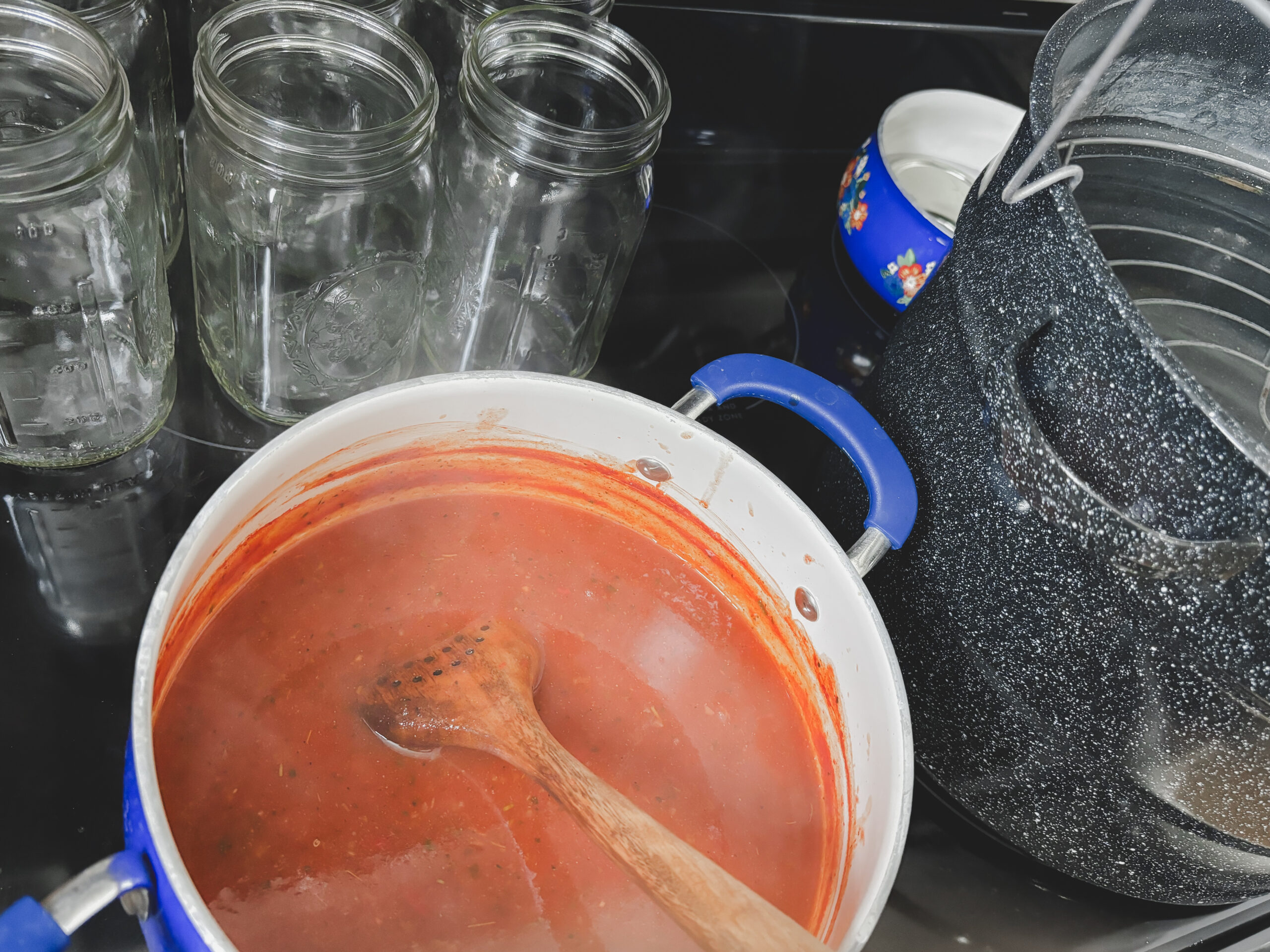
Step 4: Water Bath Canning the Pasta Sauce
Add hot water to a little over ½ of the water bath canner and bring to a boil.
Using a canning funnel and a ladle, pour the hot pasta sauce into the sterilized jars, leaving 1 inch of headspace. Remove air bubbles and wipe the jar rim with a clean damp cloth or papertowel. Using the magnet lid lifter tool, grab the jar lid from the small sauce pan, and carefully place it on the jar. Loosely screw the rings onto the lids to ensure the lids stay in place.
Place the jars on the inner wire rack of the water bath canner and lower it into the boiling water. Add the lid to the canner. Process for 40 minutes in boiling water.
After the 40 minutes is up, turn off the heat and carefully remove the canner lid. Grab the metal insert by the handles (with oven mitts) and raise the jars up, carefully hooking the handles onto the edge of the water bath canner. Let the jars sit for 5 minutes.
Lay out a hand towel or a doubled up flour sack towel on a counter surface. This will act as a barrier between the hot jars and cool counter, preventing the counter and keeping the jars from bursting with the drastic temperature change. Using the jar lifter tool, carefully remove the jars from the wire insert and place them on the towel. Allow jars to sit and cool, undisturbed, for 12-24 hours. Test jars for airtight seals. The lids will not “pop” when pushed down on and will not pop off when pulled up on.
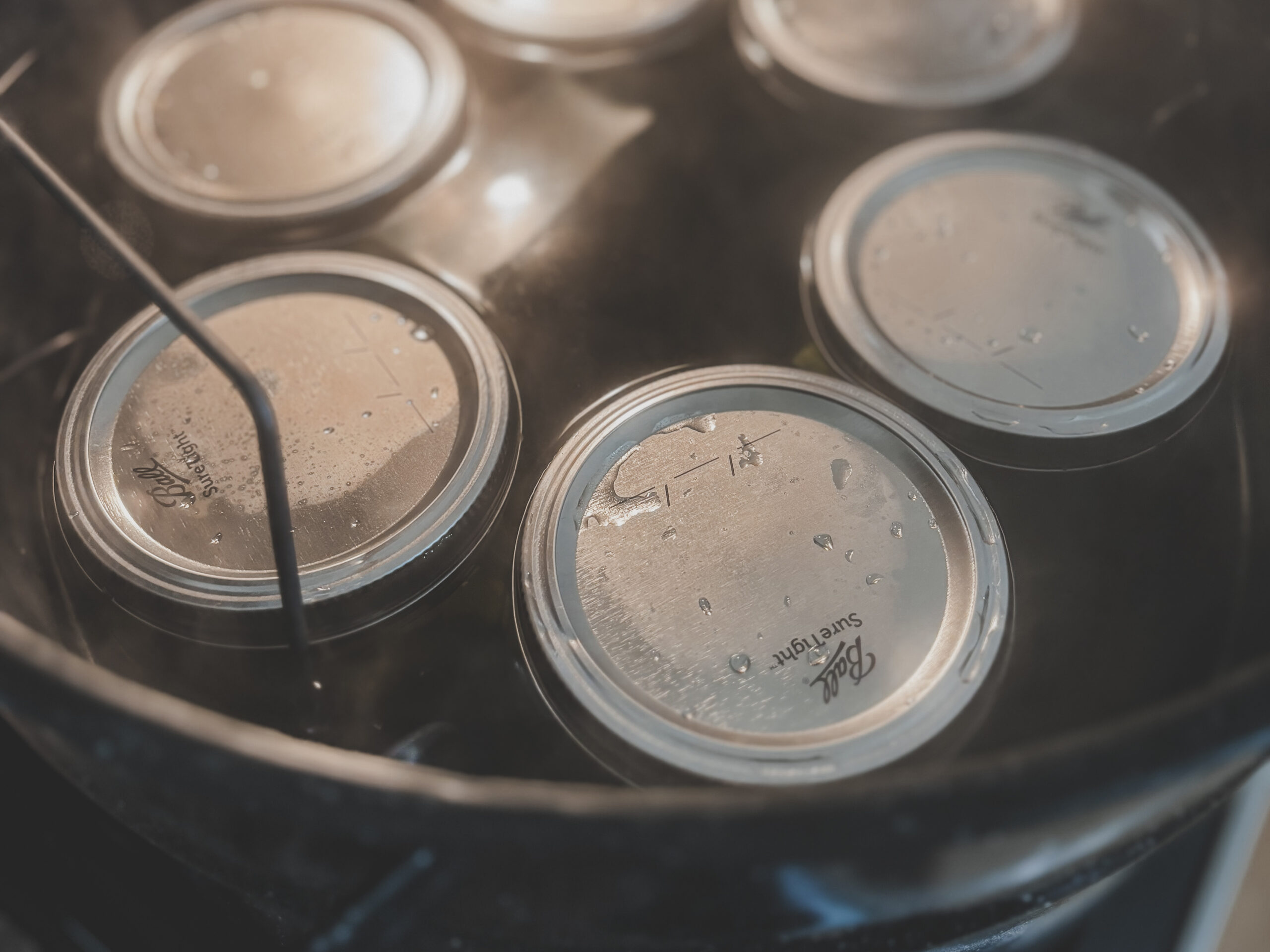
Important Notes:
- When I first started canning I would submerge the jars under the water, ensuring at least an inch of boiling water would cover the jars. This has been successful. However, I have since learned that is not necessary, and less water is required.
- Processing time of 40 minutes is appropriate for altitudes less than 1000 feet. For higher elevations, add an additional minute Increase processing time by 1 minute for each 1000 feet altitude above 1000.
- Tomatoes can have varying pH levels, so adding acid to ensure a safe level of acidity is recommended. For example: 2 tablespoons of fresh lemon juice or bottled lemon juice or ½ teaspoon of citric acid can be added to a quart jar, while 1 tablespoon of lemon juice or ¼ teaspoon of citric acid can be added to each pint jar. A pH level of 4.6 or less will prevent bacteria. However, this isn’t something I have personally ever done and I have never had an issue, and the above is a tested recipe for generations.
- The sauce master is a great tool that simplifies the process and saves a bunch of time! However, it isn’t required to process the tomatoes. Instructione for processing without a sauce master: Scald the tomatoes for 3 minutes, remove the peels and cut out the core. Run through a blender, immersion blender, or food processor or blender until smooth and drain off excess liquid.
Storage:
If a jar does not completely seal, store in the refrigerator and consume within 1 week or repackage for freezing (pour into freeze safe containers and let cool, then freeze for up to 1 year). Jars that seal will be shelf stable for up to 1 year.
Hint: Save the rejected tomato parts to make tomato powder - see my recipe here.
Alternative Preservation Methods:
- Pressure canning - this is a great method, however can be a little more intimidating for first time canners. And of course requires a pressure canner.
- Freezing - this is a great way to preserve the pasta sauce, however if freezer space is limited it may not be the best option. I like to use this as a back-up option (if for some reason a jar doesn’t seal properly).
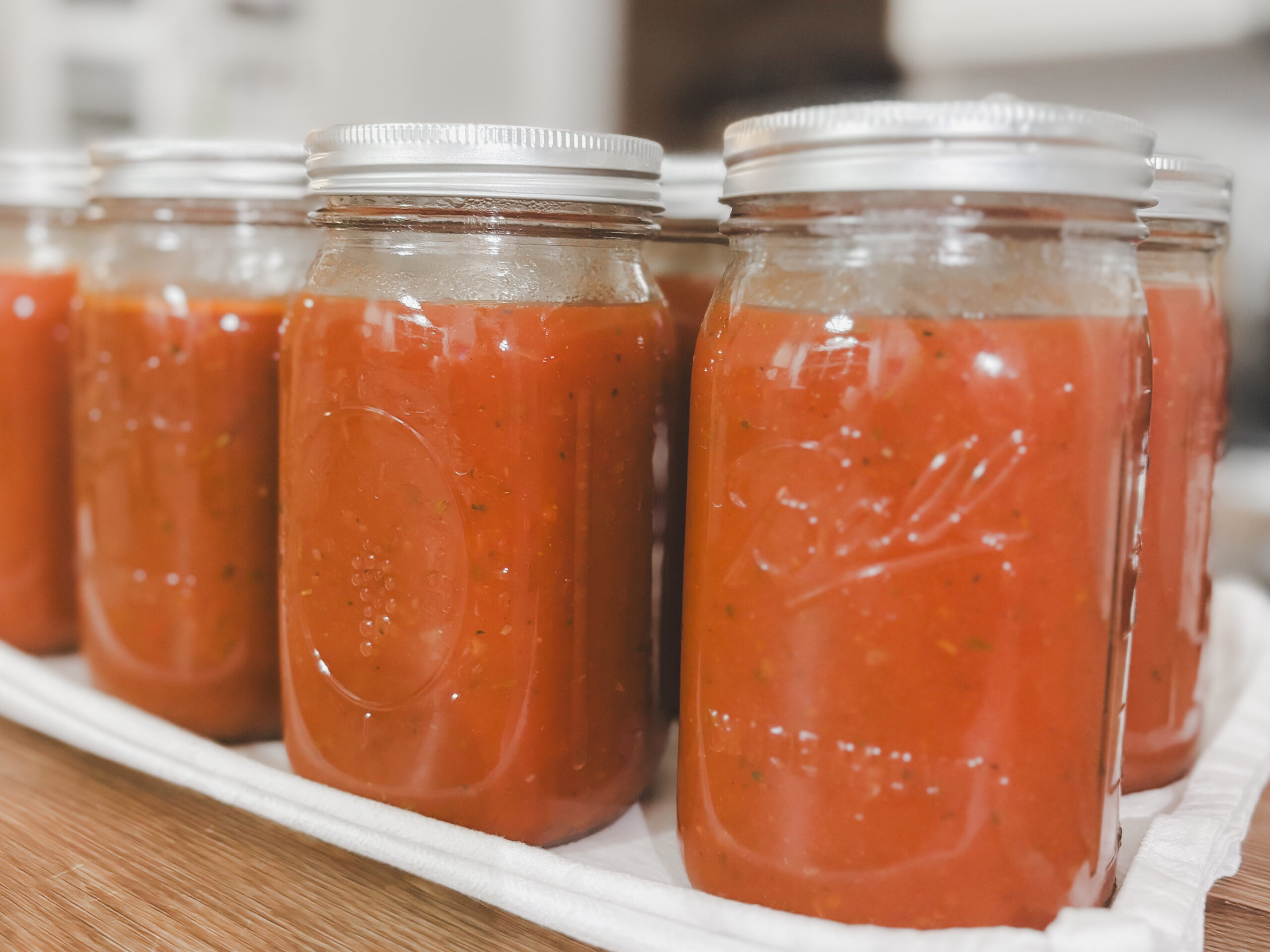
Using the Homemade Spaghetti Sauce:
First, brown a pound of ground beef in a skillet. Add in any mushrooms, onions, peppers, or additional seasonings. Once any additional ingredients are cooked down and the beef is cooked thoroughlt add in the homemade pasta sauce. Add in a 6oz can of tomato paste to thicken the sauce, and cool on medium heat. After 20 minutes, pour the sauce over cooked noodles and enjoy!
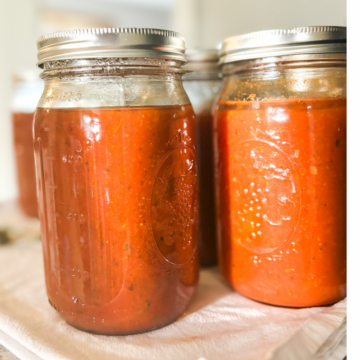
Canning Homemade Spaghetti Sauce (for Beginners)
Equipment
- Large Mixing Bowl
- Medium Mixing Bowl
- Small Mixing Bowl
Ingredients
- 6 lbs Fresh Tomatoes approximately 18 medium tomatoes
- ¼ Cup Sugar
- 1 Packet Mrs. Wages Pasta Sauce Mix
Instructions
Sterilizing the Mason Jars and Lids
- There are multiple ways to do this:- Dishwasher Method - Some dishwashers have a sanitize function on the dishwasher which works well for preparing the mason jars. The downfall, however, is this can be a time consuming method.- Oven Method - Wash the jars with soap, rinse, but do not dry. Place upside down on a baking sheet and put in the oven for 20 minutes at 275 degrees Fahrenheit (130 degrees Celsius). Carefully remove the hot jars for canning.- Boiling Method - Wash the jars with soap and rinse. Place jars in a large pot of boiling water (like the water bath canner) and let them sanitize for 20 minutes. Remove jars and let air dry before use.For the lids - place in a small sauce pan of hot water until it is time to add them to the jars.
Processing the Tomatoes
- First wash the tomatoes. Then fill the outer blanching pot (or any large pot) ⅔ full with hot water and bring to a boil. Add the tomatoes and scald for 3 minutes. (The skins will start to crack, indicating they are ready). Place the drainer insert into the sink. Poor the tomatoes from the blanching pot into the drainer insert, and rinse with cold water or ice water. Place the drainer insert with the tomatoes back into the blanching pot to transfer to the Sauce Master Food Strainer.
- Carefully add the tomatoes to the sauce master and process through the mill. Place a medium bowl below the shoot to catch the tomato sauce or tomato puree, and a small bowl below the open grind end to catch the tomato skins and seeds. See “Important Notes” section below for alternative methods.
Making the Spaghetti Sauce
- Combine the puréed tomatoes, sugar, and Mrs.Wages Pasta Sauce mix into a large non-reactive pot or saucepan. (There should be about 10 cups of puréed tomatoes - if I am doing multiple batches I will measure out 10 cups for each batch.)
- Bring to a boil, stirring occasionally. Reduce heat and simmer for 25 minutes, still stirring occasionally.
Water Bath Canning the Pasta Sauce
- Add hot water to a little over ½ of the water bath canner and bring to a boil.
- Using a canning funnel and a ladle, pour the hot pasta sauce into the sterilized jars, leaving 1 inch of headspace. Remove air bubbles and wipe the jar rim with a clean damp cloth or papertowel. Using the magnet lid lifter tool, grab the jar lid from the small sauce pan, and carefully place it on the jar. Loosely screw the rings onto the lids to ensure the lids stay in place.
- Place the jars on the inner wire rack of the water bath canner and lower it into the boiling water. Add the lid to the canner. Process for 40 minutes in boiling water.
- After the 40 minutes is up, turn off the heat and carefully remove the canner lid. Grab the metal insert by the handles (with oven mitts) and raise the jars up, carefully hooking the handles onto the edge of the water bath canner. Let the jars sit for 5 minutes.
- Lay out a hand towel or a doubled up flour sack towel on a counter surface. This will act as a barrier between the hot jars and cool counter, preventing the counter and keeping the jars from bursting with the drastic temperature change. Using the jar lifter tool, carefully remove the jars from the wire insert and place them on the towel. Allow jars to sit and cool, undisturbed, for 12-24 hours. Test jars for airtight seals. The lids will not “pop” when pushed down on and will not pop off when pulled up on.
Notes
- When I first started canning I would submerge the jars under the water, ensuring at least an inch of boiling water would cover the jars. This has been successful. However, I have since learned that is not necessary, and less water is required.
- Processing time of 40 minutes is appropriate for altitudes less than 1000 feet. For higher elevations, add an additional minute Increase processing time by 1 minute for each 1000 feet altitude above 1000.
- Tomatoes can have varying pH levels, so adding acid to ensure a safe level of acidity is recommended. For example: 2 tablespoons of fresh lemon juice or bottled lemon juice or ½ teaspoon of citric acid can be added to a quart jar, while 1 tablespoon of lemon juice or ¼ teaspoon of citric acid can be added to each pint jar. A pH level of 4.6 or less will prevent bacteria. However, this isn’t something I have personally ever done and I have never had an issue, and the above is a tested recipe for generations.
- The sauce master is a great tool that simplifies the process and saves a bunch of time! However, it isn’t required to process the tomatoes. Instructione for processing without a sauce master: Scald the tomatoes for 3 minutes, remove the peels and cut out the core. Run through a blender, immersion blender, or food processor or blender until smooth and drain off excess liquid.
Pin this post for later here!
Step-by-step instructions for preparing the tomatoes, sanitizing the jars, cooking the pasta sauce, and water bath canning the homemade spaghetti sauce - perfect for beginners.
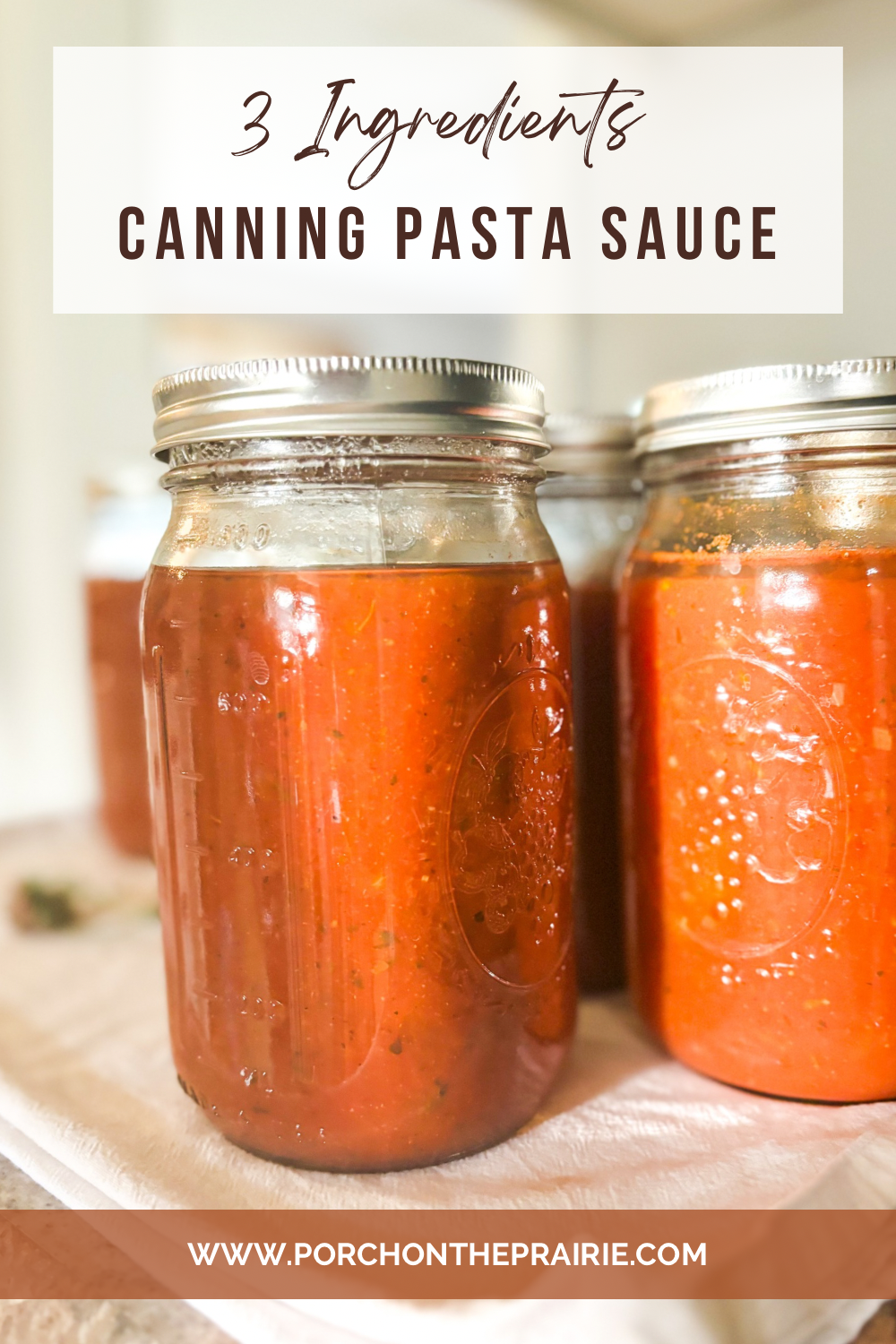
More Home Food Preservation Posts:
-
Making and Canning Homemade Applesauce - Step by Step
-
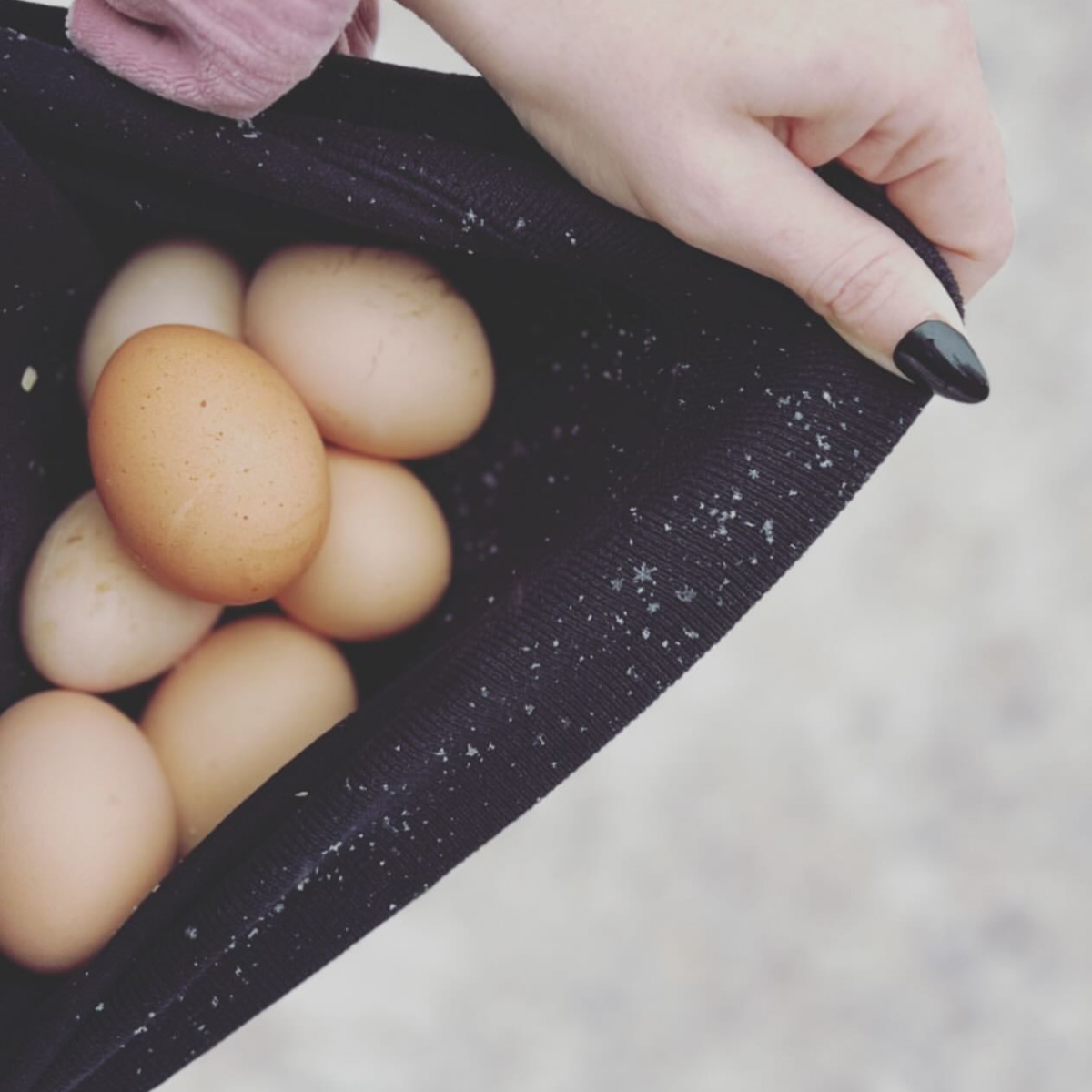
Methods for Preserving Farm Fresh Eggs for Winter
-
Pressure Canning Carrots - Easy Method (How To)

Hi, I’m Megan!
I’m the gal behind the blog, Porch on the Prairie.
My husband and I moved to our little century farm in 2021, and I’ve been learning all things homesteading ever…

